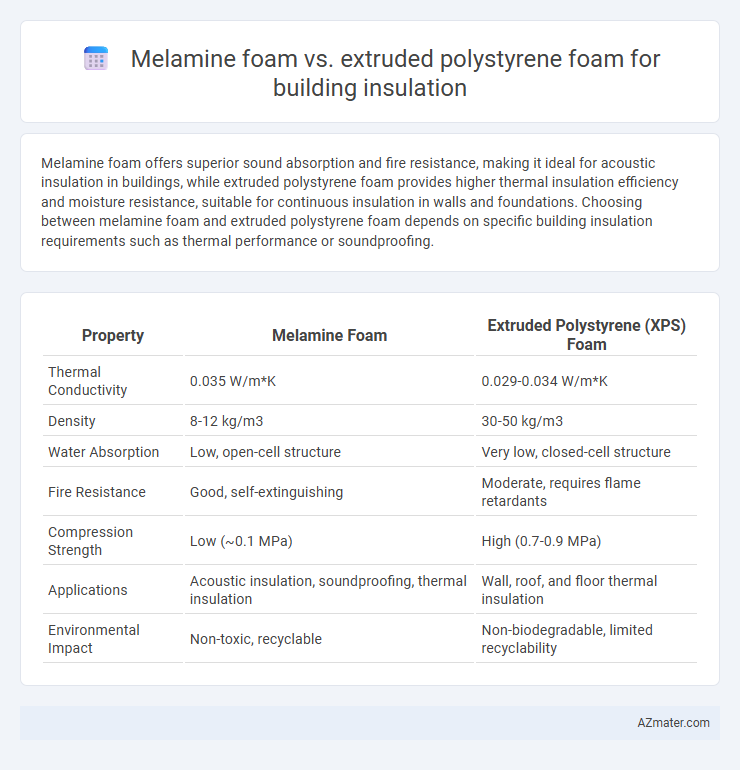Melamine foam offers superior sound absorption and fire resistance, making it ideal for acoustic insulation in buildings, while extruded polystyrene foam provides higher thermal insulation efficiency and moisture resistance, suitable for continuous insulation in walls and foundations. Choosing between melamine foam and extruded polystyrene foam depends on specific building insulation requirements such as thermal performance or soundproofing.
Table of Comparison
| Property | Melamine Foam | Extruded Polystyrene (XPS) Foam |
|---|---|---|
| Thermal Conductivity | 0.035 W/m*K | 0.029-0.034 W/m*K |
| Density | 8-12 kg/m3 | 30-50 kg/m3 |
| Water Absorption | Low, open-cell structure | Very low, closed-cell structure |
| Fire Resistance | Good, self-extinguishing | Moderate, requires flame retardants |
| Compression Strength | Low (~0.1 MPa) | High (0.7-0.9 MPa) |
| Applications | Acoustic insulation, soundproofing, thermal insulation | Wall, roof, and floor thermal insulation |
| Environmental Impact | Non-toxic, recyclable | Non-biodegradable, limited recyclability |
Introduction to Building Insulation Materials
Melamine foam and extruded polystyrene foam are popular building insulation materials, each offering distinct thermal and acoustic properties. Melamine foam excels in sound absorption and fire resistance, making it ideal for acoustic insulation and fire safety applications. Extruded polystyrene foam provides superior thermal insulation and moisture resistance, commonly used for exterior walls, roofs, and foundations to improve energy efficiency.
What is Melamine Foam?
Melamine foam is a lightweight, open-cell material known for its excellent sound absorption and thermal insulation properties, making it a popular choice in building applications. Unlike extruded polystyrene foam (XPS), which is a closed-cell, rigid foam providing high compressive strength and moisture resistance, melamine foam offers superior fire retardancy and breathability. Its unique porous structure enhances acoustic damping and thermal performance in insulation systems while maintaining environmental safety standards.
What is Extruded Polystyrene (XPS) Foam?
Extruded Polystyrene (XPS) foam is a rigid insulation material widely used in building construction for its high compressive strength, low water absorption, and excellent thermal resistance, with R-values typically around 5 per inch. Unlike Melamine foam, which is primarily used for sound absorption and fire resistance due to its open-cell structure, XPS features a closed-cell structure that provides superior moisture resistance and durability in exterior and below-grade applications. XPS foam's consistent density and moisture-repellent properties make it ideal for insulating foundations, walls, and roofs where long-term thermal performance and structural integrity are critical.
Thermal Insulation Performance Comparison
Melamine foam exhibits a low thermal conductivity typically around 0.035 W/m*K, providing excellent insulation properties with superior sound absorption and fire resistance, making it ideal for acoustic and thermal applications. Extruded polystyrene (XPS) foam possesses a thermal conductivity range of approximately 0.029 to 0.035 W/m*K, offering higher compressive strength and moisture resistance, which enhances durability and long-term insulation performance in building envelopes. While XPS foam slightly outperforms melamine foam in thermal conductivity, melamine foam's multifunctional benefits in fire retardancy and acoustic insulation make it a valuable option depending on specific building requirements.
Fire Resistance and Safety Aspects
Melamine foam exhibits superior fire resistance compared to extruded polystyrene foam, as it is inherently flame-retardant and produces low smoke and toxic gas emissions during combustion. In contrast, extruded polystyrene foam is highly combustible, releasing dense smoke and potentially harmful gases, which poses significant safety hazards in building insulation. Choosing melamine foam enhances fire safety by reducing flammability risks and improving occupant protection in case of fire incidents.
Moisture and Water Resistance
Melamine foam offers excellent moisture resistance due to its closed-cell structure, preventing water absorption and maintaining thermal performance in humid conditions. Extruded polystyrene foam also provides strong water resistance, with a high R-value and minimal water absorption that helps prevent mold growth and structural damage. Both materials are effective for building insulation, but melamine foam excels in environments with frequent moisture exposure due to its inherent hydrophobic properties.
Durability and Longevity
Melamine foam offers exceptional durability with its open-cell structure that resists compression and maintains thermal performance over time, making it ideal for insulating complex shapes in buildings. Extruded polystyrene (XPS) foam provides superior longevity due to its closed-cell composition, which offers high moisture resistance and structural strength, ensuring long-term insulation effectiveness in harsh environmental conditions. Both materials deliver reliable insulation, but XPS foam generally outlasts melamine foam in sustained outdoor or high-moisture applications.
Environmental Impact and Sustainability
Melamine foam offers superior fire resistance and recyclability compared to extruded polystyrene foam (XPS), which is derived from petroleum-based materials and often contains ozone-depleting blowing agents. XPS exhibits higher embodied carbon due to its energy-intensive manufacturing process and limited recycling options, contributing to greater environmental impact. Melamine foam's open-cell structure allows for better breathability and reduced off-gassing, enhancing indoor air quality and long-term sustainability in building insulation applications.
Cost Efficiency and Installation Considerations
Extruded polystyrene foam (XPS) typically offers greater cost efficiency for building insulation due to its lower price per board foot and widespread availability compared to melamine foam, which is generally more expensive and used in specialized applications. XPS provides easy installation because it is rigid, moisture-resistant, and can be cut to fit standard framing, reducing labor time and complexity on-site, whereas melamine foam's flexible, softer nature often requires more careful handling and specialized installation techniques. The durability and thermal resistance of XPS make it a more practical choice for large-scale insulation projects aiming to balance performance with budget constraints.
Best Applications for Melamine Foam vs XPS in Construction
Melamine foam excels in acoustic insulation and fire-resistant applications due to its open-cell structure and high temperature tolerance, making it ideal for soundproofing walls and ceilings and thermal insulation in HVAC systems. Extruded polystyrene foam (XPS) offers superior compressive strength and moisture resistance, which suits it perfectly for below-grade foundation walls, roof insulation, and exterior wall sheathing. Choosing melamine foam benefits indoor environments requiring noise reduction and fire safety, whereas XPS is preferred for structural and moisture-prone areas needing durable, high-performance thermal insulation.

Infographic: Melamine foam vs Extruded polystyrene foam for Building insulation
 azmater.com
azmater.com